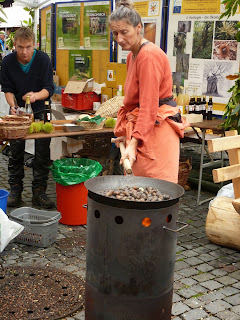Commerce Kitchen in Huntsville, Alabama offers superb
food, in a bistro setting. That’s
really all I need to say, but then what the hell, maybe I’m being a little hard
on myself. The first question, followed by a bunch
more: Why would you want to eat
there? Why would you want to drive
eight hours to eat there? What kind of food? What’s the atmosphere?
I’m so sorry I opened this up to questions.
I’ll fling a name out. Jimmy Boyce.
Learned the restaurant business across the county. Le Cirque in New Yoak. Years in L.A. and that doesn’t mean
Lower Alabama. Opened Cotton Row
in Huntsville in 2008 and has a pizza joint in the Huntsville Art Museum. High end. Low end.
Commerce Kitchen, which Boyce owns with his wife and a business partner,
fits in the middle. He said he
wanted the feel of a 1950’s steak house.
I think he missed the mark there, but that’s a good thing. I strolled through the doors, into a
dimly lit tangle of patrons clustered at an intimate bar. Crowded, but not noisy. This was a 1950s steak house all right,
but one designed by a French bistro chef.
 |
| Into the small, but inviting bar |
 |
| Even the floors sport a casual elegance |
 |
| Just the time and place for a bit of Jameson |
Living in Europe, as I do, I immediately felt at
home. Comfortable. Ready for a pre-meal libation and a
chat with folks who might have something to say. Europeans are like that. They have not lost the art of conversation, nor the ritual
of easing into a slow evening of dining.
To Europeans, dining is a sacred respite from the cares of
the day. Relaxing. Catching up with friends and
family. It doesn’t end there. What’s different about bistro fare in
France, Italy, Spain, or Germany?
Freshness of ingredients. Care in
preparation. Attention to detail,
whether it’s the placement of silverware and glasses, or the lighting, and the
way the attentive staff is not only well dressed, but knowledgeable.
 |
| It's the small touches |
Commerce Kitchen fits solidly in the bistro
world. You want to ease in. You want to linger. Also this is Alabama, the heart of
Dixie. Life slows down. Commerce
Kitchen is not only bistro in ambiance, but southern in charm.
Boyce wanted it that way. He got it. As
author Steve Doyle quoted Boyce in AL.com, "It's not going to be duck
liver and caviar. "It's going to be very familiar foods with our twist on
it."
Here you find shrimp and grits, grilled salmon, rib-eye steak,
and grits with short ribs. But,
always with a twist. Our waiter
knew all about it. He’d worked in
the kitchen and could describe the recipes to a T.
 |
| At 7:30 p.m. the crowds had yet to arrive |
Nice touch, that.
I’m a fan of everyone in a business knowing all about that
business. I asked him about the
glassware and it wasn’t a test. I
liked the glassware. He knew the
style and the company name.
“Ok,” you’re thinking, “enough of the small talk. Give me a few hints about the food.”
 |
| Shrimp and Grillades |
Gladly. I
started with the grits and short ribs, or Grillades as they’re called on the
menu. The name comes from New
Orleans and means meat, usually beef, slow cooked with stock and vegetables
until the meat falls into shreds, resting in a dark, indescribably delicious
sauce. The waiter recommended the
dish and as soon as I bit in, I wanted to kiss him. This was stewed meat over creamy grits taken to the level of
angels. The sauce was so rich I
still dream about it.
What followed was a medium rare, blackened steak, with
tender-crisp vegetables and a stack of crisp onion rings. The steak
was so tender no knife needed.
Yes, you can get steak practically anywhere. No, you cannot get it cooked to perfection everywhere. This was special. A steak worthy of the name.
 |
| Tender, tender Rib-eye |
 |
| The Kitchen's take on Pork and Beans - Pork Belly and Blackeyed Peas! |
 |
| Smooth and creamy shrimp and grits |
Dessert? Are
you kidding? Of course! You’re only fat once! Absolutely decadent. Chocolate Pecan Pie. A dollop of luscious whipped cream on
top. I’m still ashamed of myself.
How long were the five of us there? Beats the hell outta me! We talked of food and family and the
pleasures of life. Our waiter had
a sixth sense about appearing when we needed him.
People often talk about a ‘feeding frenzy.’ You don’t go to Commerce Kitchen for
that. You go to slow your life
down, chat with friends, and ease your way through an evening meal you will
never forget. If you wannta try and beat Commerce Kitchen, buy yourself a
ticket to France. This was the
best meal I’ve had in the U.S.A.


















































